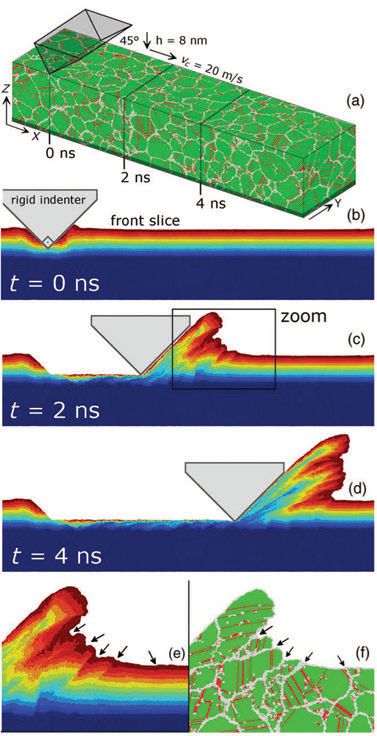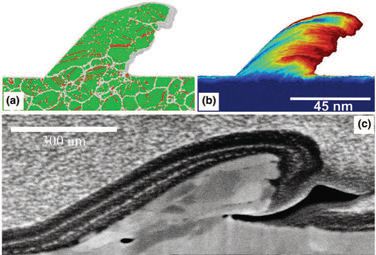Into the fold
Drs. Wilfred T. Tysoe & Nicholas D. Spencer | TLT Cutting Edge April 2015
The onset of wear—and ways to reduce it—emerge from an exciting modeling and experimental collaboration.
UNCONSTRAINED PLASTIC FLOW (UPF) OF METAL SURFACES IN A SLIDING CONTACT with hard asperities is a common tribological occurrence, whether it be deliberate (e.g., in machining) or accidental (wear processes on metal surfaces). In the latter case, UPF—and thus wear—can be influenced by preconditioning the surfaces, using processes such as lapping, honing or running in. These techniques are known to modify the crystalline structure, topography and even to some extent the chemical composition in the surface-near region. Precisely how these influence wear has not, up to now, been very clear.
Some recent observations have suggested that UPF of metal surfaces is not a laminar process, as had been previously assumed, but can produce vortex-like fold structures, which are a precursor to wear-particle formation. A team led by Peter Gumbsch, Michael Moseler and Martin Dienwiebel at the Fraunhofer Institute for Mechanics of Materials in Freiburg, Germany, in collaboration with industrial colleagues at Robert Bosch GmbH, have scrutinized the processes occurring during UPF. They applied a powerful combination of massive molecular-dynamics simulations with atomic-force-microscopy scratch experiments to investigate the plowing of a rigid indenter across a polycrystalline copper surface.
Figure 1 shows the results of the simulation. Figure 1(a) shows the polycrystalline nature of the copper, the atoms being color coded to show their local environment: the face-centered cubic copper (green), the location of stacking faults (red) and grain boundaries (gray). Figure 1(b) illustrates the beginning of sliding, the atoms being color coded by their initial vertical position. Figures 1(b-d) show the time evolution, corresponding to the positions indicated in Figure 1(a). The emergence of a folded structure with a rough front face is quite clear. Figure 1(e) and 1(f) show closeups of the folded chip in Figure 1(c), color coded for initial position and local environment, respectively. It is quite clear that the folds are occurring between the grain boundaries (arrows). The bulging is therefore attributed to dislocation-mediated plasticity, rather than grain-boundary phenomena. Upon more closely examining the bulging phenomenon, it also could be observed that the crystallographic orientation of the grains plays a major role in the process. Grains with slip planes parallel to the indenter motion are more prone to bulge. Furthermore, the grains in the growing chip merge, by grain-boundary migration and lattice reorganization, until the chip is essentially a single grain (see Figure 2(a)).
 Figure 1. Molecular-dynamics simulation of unconstrained surface plastic flow. (Illustration courtesy of the American Physical Society.)
Figure 1. Molecular-dynamics simulation of unconstrained surface plastic flow. (Illustration courtesy of the American Physical Society.)
 Figure 2. (a) Simulation after 6.5 ns, color coded by local environment and (b) initial position. (c) This shows a cross-section of a copper surface, following a scratch experiment by a diamond tip in an atomic force microscope. (Illustration courtesy of the American Physical Society.)
Figure 2. (a) Simulation after 6.5 ns, color coded by local environment and (b) initial position. (c) This shows a cross-section of a copper surface, following a scratch experiment by a diamond tip in an atomic force microscope. (Illustration courtesy of the American Physical Society.)
The experimental procedure used a diamond tip in an atomic force microscope, which slid across a copper surface under ambient conditions, after which a focused-ion beam could be used to cut out a cross-section of the track for scanning-electron-microscopy imaging. The results (
see Figure 2) show a striking similarity between the modeling and experimental study, and the dark regions between the grains in Figure 2(c) indeed suggest that oxide from the external copper surface has been incorporated into the bulk, consistent with the model’s predictions. Further reciprocating sliding led to the splitting of chips into nanolamellae—the precursor of the frequently observed lamellar wear debris.
The simulations confirmed by the AFM studies show that the crystallographic orientation of the slip systems in the surface grains plays a major role in their bulging behavior, which subsequently leads to chip growth and the formation of wear debris. This leads to the interesting possibility that deliberately modifying grain orientation in the surface region, by severe plastic deformation, machining or doping to prevent grain growth, could significantly impact wear behavior. Fundamental studies could pave the way for a new generation of engineered, wear-resistant surfaces.
REFERENCE
1.
Beckmann, N., Romero, P.A., Linsler, D., Dienwiebel, M., Stolz, U., Moseler, M. and Gumbsch, P. (2014), “Origins of Folding Instabilities on Polycrystalline Metal Surfaces,”
Physical Review Applied,
2, 064004.
 Eddy Tysoe is a Distinguished Professor of Physical Chemistry at the University of Wisconsin-Milwaukee. You can reach him at wtt@uwm.edu
Eddy Tysoe is a Distinguished Professor of Physical Chemistry at the University of Wisconsin-Milwaukee. You can reach him at wtt@uwm.edu.
 Nic Spencer is professor of surface science and technology at the ETH Zurich, Switzerland. Both serve as editors-in-chief of STLE-affiliated Tribology Letters journal. You can reach him at nspencer@ethz.ch
Nic Spencer is professor of surface science and technology at the ETH Zurich, Switzerland. Both serve as editors-in-chief of STLE-affiliated Tribology Letters journal. You can reach him at nspencer@ethz.ch.